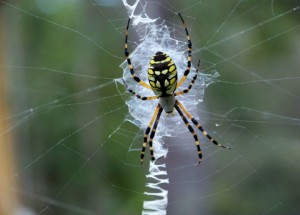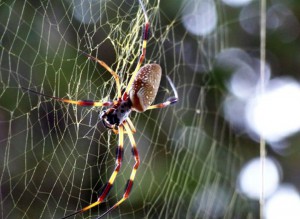TELL ME NO! Please tell me these huge spiders are not a part of our summer. People are afraid snakes… that’s a given – but there are just as many afraid of spiders. Honestly, after years of leading field hikes into the north Florida environment, when we encounter a spider web on the trail I have heard more screams from the boys than from the girls. But most are afraid and there nothing is more terrorizing than the huge, almost hand-size, Golden Orb Weaver (or banana spider).
The Golden Orb Weaver is one of 180 species of orb weavers from around the world; one from Australia is large enough to feed on small birds. The local species is Nephila clavipes and is found throughout the southeastern United States; in the warmer months it may reach as far north as New England. Female Orb Weavers are the really big ones you find on the webs. Their body lengths can reach 2” (not including the extended legs) and the males are much smaller at 0.02”. They have long inward pointing legs with hair-like tuffs at the joints. These are very useful in web building. They have the typical “red/yellow/black” coloration of a venomous animal and their mimics; but N. clavipes is no mimic… though mild, they do have venom. There is another orb weaver spider that is large a constructs large webs. This is the Black and Yellow Argiope (Agriope aurantia). One way to distinguish this spider from the Golden Orb is the “zig-zag” pattern it adds to its’ web near the center (where the spider spends a lot of its time).

The zig-zag pattern of the Black and Yellow Argiope spider helps to distinguish from the Golden Orb. Photo: Molly O’Connor
The name “Golden Orb” does not come from their body coloration but from the color of the silk produced for their webs. It is believed that the yellow/golden color of this silk makes it difficult for others to see in open sunny areas. Many hikers can attest to this… they are hard to see, until you become entangled… then become aware the large spider is very close and heading your way… then the scream. N. clavipes can actually adjust the hue of yellow in the silk to match the sunlight conditions where it is building its web. It is amazing to see how quickly they replace their large webs, over 3 feet in diameter, after they have been removed by people. Actually they mend and move their webs regularly. They tend to build them off ground, at eye level to the tree tops, in open areas near a line of trees. I have actually seen one build the web across a dirt road between two stands of pines as if it were going to try and capture a truck! Though species of Orb Weavers feed on small birds and snakes, N. clavipes prefers flying insects. They do not wrap their prey in silk for later feeding, as many spiders do, but rather consume them almost immediately. This may be because of a small slivery spider called Argyrodes. This spider feeds on the captured food of other spiders. N. clavipes feeding may be an adaptation to combat this kleptoparasitic spider. Another interesting behavior I have noticed is when the heavy rains come. I have noticed the web remains but the spiders leave. I am not sure where they go, most likely a hiding spot nearby, but they do leave.
The fear of spiders is most likely similar to the fear of snakes… they are venomous. Venom is used to kill prey and many times is not strong enough to kill humans, but the fact that some species can kill makes folks a bit nervous. Despite local tales that say otherwise, the venom of N. clavipes is mild. It is a neurotoxin, which can be potent, but the bite from this spider is not lethal. The typical response is pain and redness at the site of the bite, blisters may form, but it is actually less potent than a bee sting.
Like many other species of spiders, the Golden Orb Weaver is a beneficial backyard creature consuming hundreds of biting (in some cases disease carrying) insects. The large webs can be a nuisance around backyard patios and swimming pools but they can easily be moved to other locations with a rake or broom. We have many of them in our yard, one out of my office window, and enjoy watching them work. They are good panhandle neighbors.
For more information on these beneficial creatures visit:
http://okeechobee.ifas.ufl.edu/News%20columns/Orbweaver.spiders.htm
http://edis.ifas.ufl.edu/in017
http://edis.ifas.ufl.edu/in467
- Tips for Bear Encounters this Fall - November 10, 2025
- Pensacola Bay Invasive Species Summer Survey 2025 - November 3, 2025
- Our Environment: Part 24 – Our Changing Climate - November 3, 2025

